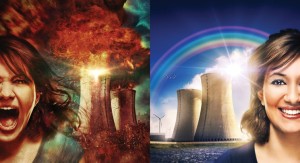The Millennial’s Dilemma: A Young Writer’s Search for Our Nuclear Future in Chernobyl, Fukushima, and Phoenix
After a cold and drizzly morning this past May, the sun is finally out in the Exclusion Zone, the heavily guarded area around the Chernobyl Nuclear Power Plant in northern Ukraine.
The circular-shaped zone — which has a radius of 30 kilometers (18.6 miles) — is located about 60 miles north of Kiev, the capital city of Ukraine, and about nine miles south of the border with Belarus. It’s full of tall pine trees and big, open, green fields where wild horses and deer graze. The area is so quiet, so deserted, and so overgrown that it’s hard to imagine it was once home to more than 130,000 people.
It took the Soviets five years to build Chernobyl, and the plant began producing power in 1977. Unlike those constructing power plants in the U.S. and western Europe, though, they didn’t build strong concrete and steel containment buildings around their nuclear reactors. So when a safety test went awry on April 26, 1986, and caused a big explosion inside Reactor No. 4, huge amounts of radiation were released into the atmosphere.
Thirty years later, the area is still officially uninhabitable. Most spots inside the 30-kilometer zone aren’t particularly radioactive, but still, anyone who works there — from the guides to the thousands of nuclear scientists, construction workers, cooks and hotel workers, and military security guards — can only spend a certain number of consecutive days inside the zone and must consent to regular medical examinations. Any tourist wishing to visit the area must be part of a government-approved group.
The Exclusion Zone is eerie and decaying, a hauntingly beautiful time capsule. Nine other tour participants and I walk over broken glass, scattered papers, and things I assume were once clothes or blankets. I explore rooms filled with rusty, antiquated medical equipment in an abandoned hospital, and dozens of classrooms filled with desks — sometimes still lined up in rows and piled high with paperback books. There are children’s drawings and alphabet flashcards all over the desks and floors in one of the classrooms, and a giant pile of child-sized gas masks in the corner of another.
In some buildings, we have to creep along the edges of a room because parts of the floor are rotted out. We walk in a zigzag pattern to avoid the leaking ceilings and puddles in long, windowless hallways…
I assume that given the chance to go anywhere, most people wouldn’t choose to visit the site of the world’s largest nuclear disaster. But I did.
I wanted to walk around the overgrown and crumbling central squares of abandoned cities and villages, and see what a house looks like after a frightened family packs only a small bag of belongings and never returns. I wanted to see Chernobyl, 30 years later.
The week before, I had visited Fukushima Prefecture in Japan, home of the second largest nuclear disaster in history, the 2011 triple meltdown at the Fukushima-Daiichi Nuclear Power Plant (prefectures are the Japanese version of states).
In both cases, I wanted to know how a country recovers from a nuclear accident and how its citizens feel about it, because in the last year, I’ve become obsessed with nuclear power and how I should feel about it.
This all began when I moved to Arizona from the East Coast two years ago and realized that I suddenly was living in the fallout zone of the Palo Verde Nuclear Generating Station, the country’s largest nuclear power plant. (Continue reading at the Phoenix New Times.)
